
Art Nouveau is an international style of art, architecture, and applied art, especially the decorative arts. It was often inspired by natural forms such as the sinuous curves of plants and flowers. Other characteristics of Art Nouveau were a sense of dynamism and movement, often given by asymmetry or whiplash lines, and the use of modern materials, particularly iron, glass, ceramics and later concrete, to create unusual forms and larger open spaces. It was popular between 1890 and 1910 during the Belle Époque period, and was a reaction against the academicism, eclecticism and historicism of 19th century architecture and decorative art.

Louis Comfort Tiffany was an American artist and designer who worked in the decorative arts and is best known for his work in stained glass. He is associated with the art nouveau and aesthetic art movements.

The Charles Hosmer Morse Museum of American Art, a museum noted for its art nouveau collection, houses the most comprehensive collection of the works of Louis Comfort Tiffany found anywhere, a major collection of American art pottery, and fine collections of late-19th- and early-20th-century American paintings, graphics and the decorative arts. It is located in Winter Park, Florida.
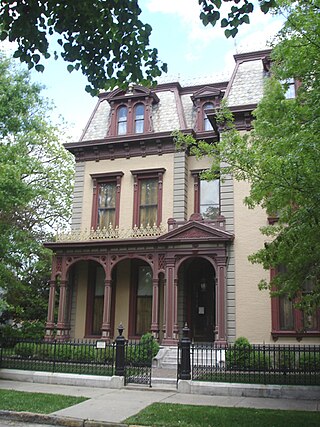
The Reitz Home Museum is a Victorian house museum located in the Riverside Historic District in downtown Evansville, Indiana. The museum offers year-round guided tours.

The Bavarian National Museum in Munich is one of the most important museums of decorative arts in Europe and one of the largest art museums in Germany. Since the beginning the collection has been divided into two main groups: the art historical collection and the folklore collection.
The Smith Museum of Stained Glass Windows was an exhibition that opened in February 2000 at Chicago’s Navy Pier entertainment complex. It permanently closed in October 2014. It was the first American museum dedicated solely to the art of stained glass windows.
Richard Herman Driehaus was an American businessman, investor, and philanthropist. He was the founder, chief investment officer, and chairman of the hedge fund, Driehaus Capital Management LLC, based in Chicago.
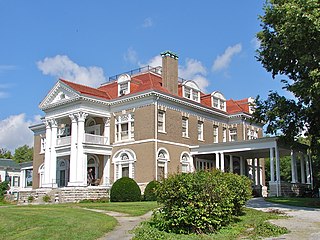
Rockcliffe Mansion is located in Hannibal, Missouri (USA) and was built in 1898 by John J. Cruikshank, Jr, a descendant of Scottish immigrants, whose fortune was founded on lumber. He erected the residence on West Bird Street. It came to be acknowledged as the most imposing, beautiful and costly residential structure in that part of the state of Missouri. "By reason of its location on a high, rocky eminence, overlooking the entire city [and the Mississippi River], it [was] termed 'Rock Cliff' [later known as "Rockcliffe"], and is one of the many attractions of the city invariably viewed by strangers and tourists visiting Hannibal." It is located in the Maple Avenue Historic District.
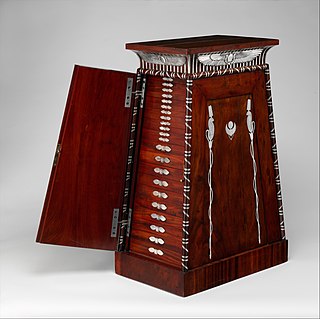
Egyptian revival decorative arts is a style in Western art, mainly of the early nineteenth century, in which Egyptian motifs were applied to a wide variety of decorative arts objects.
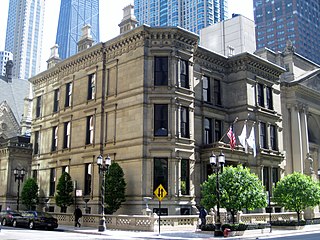
The Samuel M. Nickerson House, located at 40 East Erie Street in the Near North Side neighborhood of Chicago, Illinois, is a Chicago Landmark. It was designed by Edward J. Burling of the firm of Burling and Whitehouse and built for Samuel and Mathilda Nickerson in 1883. Samuel M. Nickerson was a prominent figure in the rising national banking industry, who was said to have owned at one point more national bank stock than anyone else in the United States.

Casa Wiechers-Villaronga is a Classical Revival style mansion in Ponce, Puerto Rico designed and built in the early twentieth century. The house was acquired and restored by the Institute of Puerto Rican Culture and now operates as the Museo de la Arquitectura Ponceña. The house sits in the Ponce Historic Zone. The Villaronga Residence is an outstanding example of the Classical Revival style in used in Ponce designs in the early part of the 20th century and is one of two residences still standing of a series of houses designed and built by Alfredo B. Wiechers, so important to the architectural and cultural heritage of the city of Ponce.

The Haworth Art Gallery is a public art gallery located in Accrington, Lancashire, northwest England, and is the home of the largest collection in Europe of Tiffany glass from the studio of Louis Comfort Tiffany. The museum, a Tudor-style house, was originally built in 1909 to be the home of William Haworth, a manufacturer of textiles. The house was designed by Walter Brierley (1862–1926), a York architect known as "the Yorkshire Lutyens". It was bequeathed to the people of Accrington in 1920, and stands in nine acres of parkland on the south side of Accrington Town Centre.
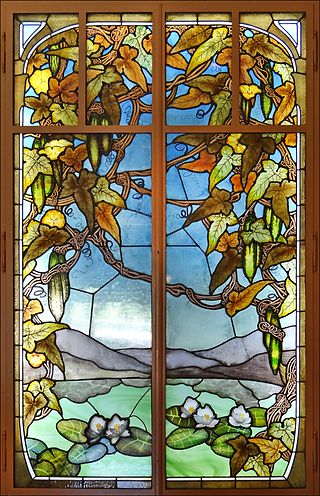
École de Nancy, or the Nancy School, was a group of Art Nouveau artisans and designers working in Nancy, France between 1890 and 1914. Major figures included the furniture designer Louis Majorelle, ebonist and glass artist Jacques Grüber, the glass and furniture designer Émile Gallé, and the crystal manufactory of Daum. Their work was largely inspired by floral and vegetal forms found in the region. The goal of the group was to produce in series ordinary objects, such as furniture, glassware, and pottery, with fine craftsmanship and in original forms, making art objects available for people's homes.

The Villa Majorelle is a house located at 1 rue Louis-Majorielle in the city of Nancy, France, which was the home and studio of the furniture designer Louis Majorelle. It was designed and built by the architect Henri Sauvage in 1901-1902. The villa is one of the first and most influential examples of the Art Nouveau architectural style in France. It served as a showcase for Majorelle's furniture and the work of other noted decorative artists of the period, including ceramist Alexandre Bigot and stained glass artist Jacques Gruber. It is now owned by the city of Nancy, and is open to the public certain days for tours by reservation.
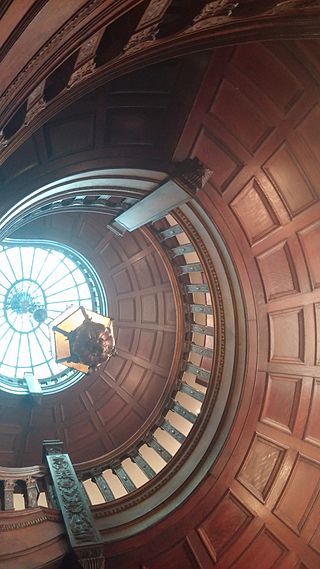
The Garrett Jacobs Mansion is a historic home located in the Mount Vernon neighborhood of Baltimore, Maryland. Built in 1853 by Samuel George, the home gets its name from its last and most famous owner, Mary Frick Garrett Jacobs, who, with her husband Robert Garrett, transformed the home into a prime example of the Gilded Age mansions of the city.

The Art Nouveau movement of architecture and design first appeared in Brussels, Belgium, in the early 1890s, and quickly spread to France and to the rest of Europe. It began as a reaction against the formal vocabulary of European academic art, eclecticism and historicism of the 19th century, and was based upon an innovative use of new materials, such as iron and glass, to open larger interior spaces and provide maximum light; curving lines such as the whiplash line; and other designs inspired by plants and other natural forms.

Louis J. Millet was an educator, industrial art school founder, and interior designer in the United States. He was a celebrated stained glass artist. He worked on Louis Sullivan and George W. Maher projects and went into business with portraitist George Healy at the interior design firm Healy & Millet offering services including interior decoration, floor tiling, and wood mantels. Millet was nationally known for his decorative work, frescoes, and stained glass.
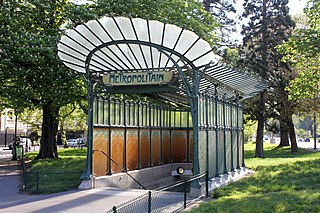
The Art Nouveau movement of architecture and design flourished in Paris from about 1895 to 1914, reaching its high point at the 1900 Paris International Exposition. with the Art Nouveau metro stations designed by Hector Guimard. It was characterized by a rejection of historicism and traditional architectural forms, and a flamboyant use of floral and vegetal designs, sinuous curving lines such as the whiplash line, and asymmetry. It was most prominent in architecture, appearing in department stores, apartment buildings, and churches; and in the decorative arts, particularly glassware, furniture, and jewelry. Besides Guimard, major artists included René Lalique in glassware, Louis Majorelle in furniture, and Alphonse Mucha in graphic arts, It spread quickly to other countries, but lost favor after 1910 and came to an end with the First World War.

The whiplash or whiplash line is a motif of decorative art and design that was particularly popular in Art Nouveau. It is an asymmetrical, sinuous line, often in an ornamental S curve, usually inspired by natural forms such as plants and flowers, which suggests dynamism and movement. It took its name from a woven fabric panel called "Coup de Fouet" ("Whiplash") by the German artist Hermann Obrist (1895) which depicted the stems and roots of the cyclamen flower. The panel was later reproduced by the textile workshop of the Darmstadt Artists Colony.

Art Nouveau glass is fine glass in the Art Nouveau style. Typically the forms are undulating, sinuous and colorful art, usually inspired by natural forms. Pieces are generally larger than drinking glasses, and decorative rather than practical, other than for use as vases and lighting fittings; there is little tableware. Prominently makers, from the 1890s onwards, are in France René Lalique, Emile Gallé and the Daum brothers, the American Louis Comfort Tiffany, Christopher Dresser in Scotland and England, and Friedrich Zitzman, Karl Koepping and Max Ritter von Spaun in Germany. Art Nouveau glass included decorative objects, vases, lamps, and stained glass windows. It was usually made by hand, and was usually colored with metal oxides while in a molten state in a furnace.

































